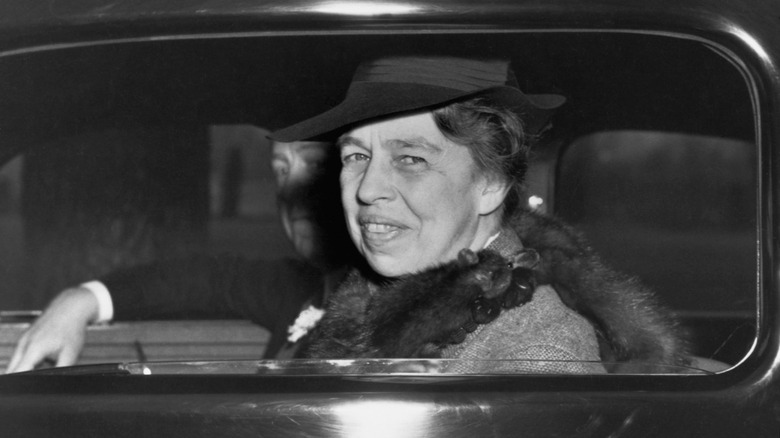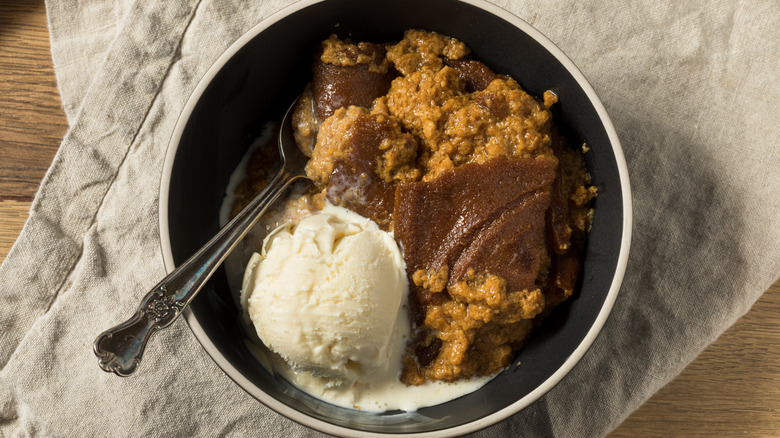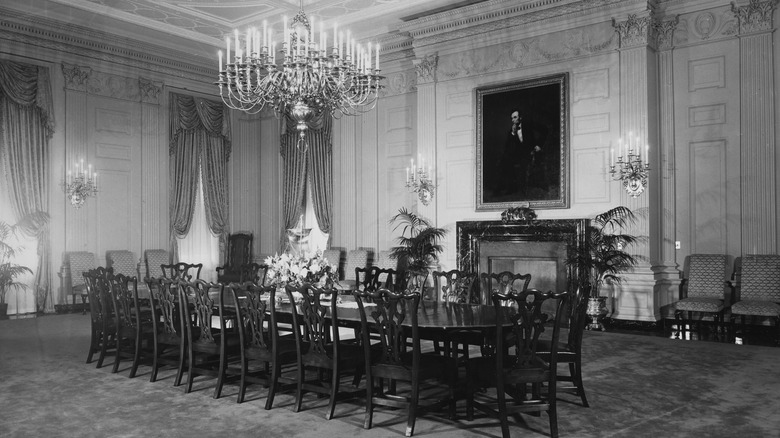The Depression-Era Dessert Eleanor Roosevelt Loved With A Passion
Eleanor Roosevelt served as First Lady during her husband Franklin D. Roosevelt's historic four-term presidency, the majority of which was during the Great Depression. With an eye on being economical, she was determined to serve foods that were inexpensive yet nutritious. While this often came at the cost of flavor in meals served at the White House, the one simple dessert that she loved enough to serve instead of pumpkin pie on Thanksgiving was a classic American dessert called hasty pudding.
Hasty pudding, also known as Indian pudding, was also a favorite of First Lady Abigail Adams, who hailed from New England where the cornmeal-based pudding was first made by American colonists. The original English version of the pudding was made with flour, but the colonists used corn since it was less expensive and more readily available. Early recipes for the pudding combined cornmeal with a liquid like milk or water. A recipe in the very first American cookbook, "American Cookery" by Amelia Simmons, calls for combining the cornmeal with scalded milk before adding eggs, raisins, butter, spice, and sugar, then baking. At an hour and a half baking time, it's not exactly as quick to make as its name would suggest — instead, the moniker refers to the simplicity of its preparation.
Since 1796, when Simmons' recipe was published, there have been other variations that include sweeteners like maple syrup or molasses. Other recipes may call for sorghum or to serve it with ice cream on top.
Food at the White House during the Roosevelt administration
Eleanor Roosevelt's fondness for frugality was perhaps more admirable than the results that wound up on the table. In fact, the historic nature of Franklin D. Roosevelt's term may only be rivaled by the infamy of the meals served at the White House over the 12 years he was in office. Just weeks into his presidency, Eleanor proudly served a meal that clocked in at a mere seven and a half cents per person, featuring stuffed eggs with tomato sauce, wheat bread, and mashed potatoes, along with some coffee to wash it all down. Later meals would include tepid mutton with not-so-tasty peas that were served to Senator Hiram Johnson, and a soup and squab that Ernest Hemingway likened to rainwater and rubber, respectively.
While penny-pinching may have played a part in the quality of the meals served at the White House, the responsibility does not fall squarely on the First Lady. When her husband was elected president, she opted to ask a longtime acquaintance, Henrietta Nesbitt, to take on the role of head housekeeper at the White House. While Nesbitt had previously made breads and cakes that Eleanor purchased from her, she lacked experience otherwise. However, she became the leader of the kitchen staff.
The head housekeeper often served unusual combinations
Though Henrietta Nesbitt was loyal to the First Lady, she was known for being a bit stubborn in her role at the White House, often ignoring Franklin D. Roosevelt's requests and substituting her own preferences. F.D.R. appreciated fine foods like duck, lobster, and caviar, but he also happened to enjoy a good grilled cheese, too. Despite his complaints about her menus, she served meals like sweetbreads or liver for days in a row, made chicken salad when asked to make chicken à la king, and dismissed his criticism.
Visitors to the White House even spread the word to be sure to fill their stomachs before they get there. One salad that was served alongside often poorly-cooked proteins included pear halves slathered with a combination of cream cheese, cream, olives, candied ginger, and sometimes mayonnaise that had been tinted with green food coloring. Meanwhile, an appetizer that she preferred to prepare consisted of pineapple slices coated in crushed peppermint candies.
Though Eleanor Roosevelt enjoyed various cuisines on her travels, she continued to sign off on Nesbitt's menus. Seemingly without complaint, she dined on Nesbitt's concoctions, though she would sometimes scramble her own eggs. While it seems inexplicable that the First Lady would approve meals that essentially repulsed their visitors, some say that her choice was a calculated response to her husband's infidelity. Or was her love for Nesbitt's hasty pudding worth withstanding over a decade of kitchen catastrophes?



